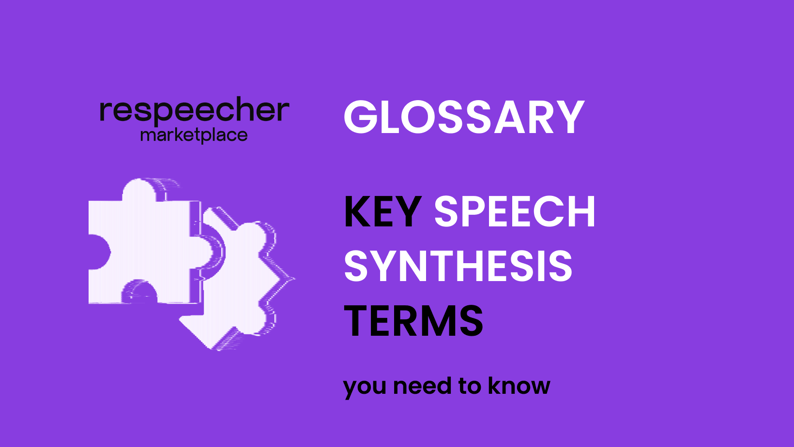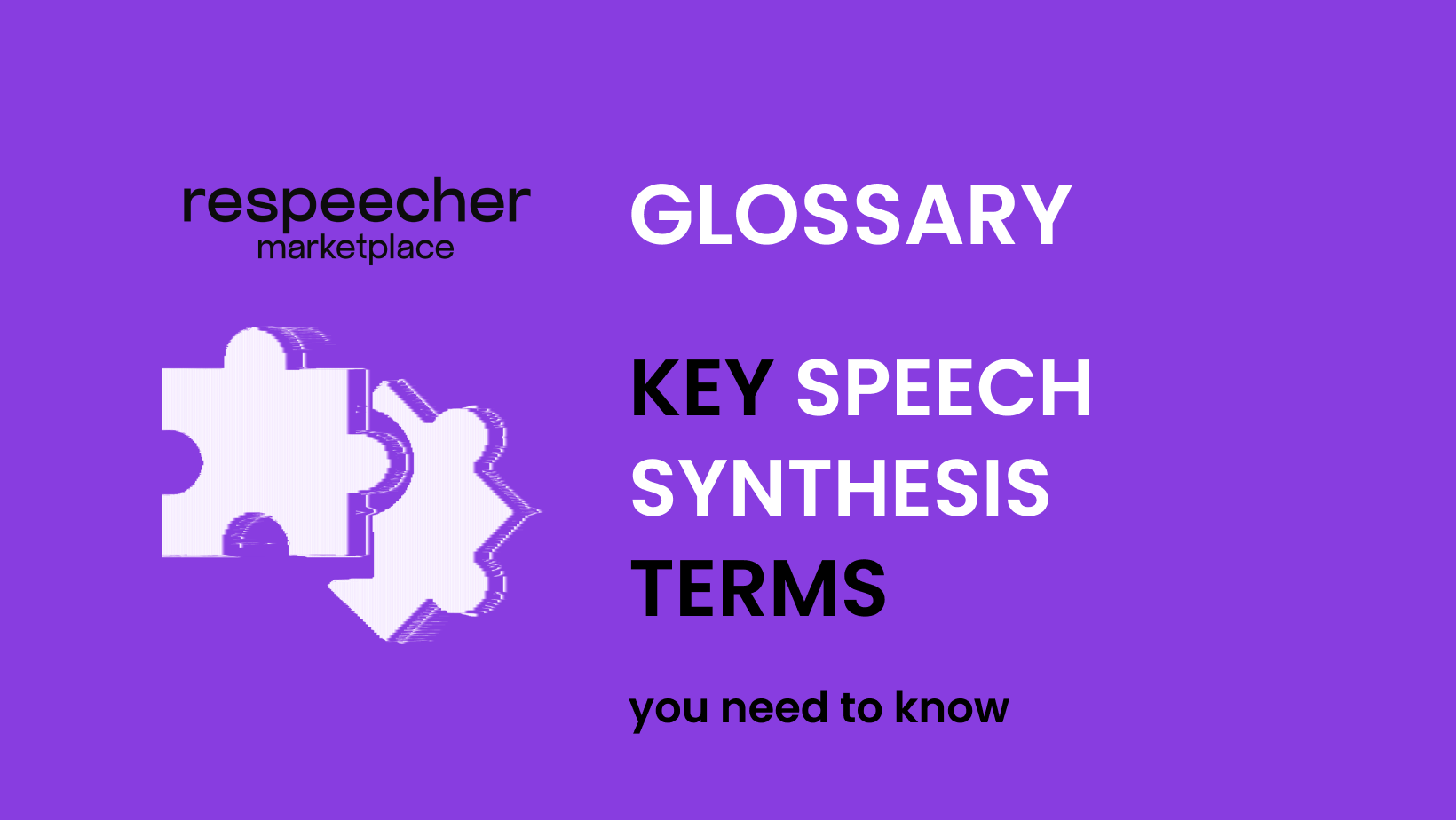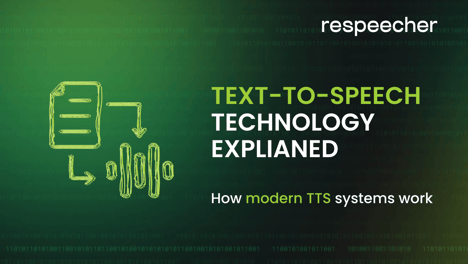Demystifying Key Speech Synthesis Terms: All That You Need to Know

Speech synthesis technology has revolutionized how we interact with computers and multimedia content. From virtual assistants responding to our queries to audiobooks aiding the visually impaired, synthetic speech has become universal. However, diving into the world of speech synthesis can be daunting due to its specialized terminology.
Here, we break down some essential terms to help you navigate this field and explain how to use this knowledge when working with Respeecher Voice Marketplace.
Basic Speech Synthesis Terms
Understanding basic speech synthesis terms is essential for navigating the world of artificial speech generators. These terms underpin technologies that power virtual assistants, aid the visually impaired, and facilitate voice changing in various media productions.
-
Synthetic Speech: Artificially generated human speech produced by computers. This technology finds applications in virtual assistants, text-to-speech systems, and more, enabling verbal interactions in various contexts.
-
Speech-to-Speech (STS): A voice conversion technology, also called voice cloning, transforming spoken input from one voice to sound as though spoken by another specific voice. Widely used in film production, video game development, and call centers, it offers versatility in voice changing.
-
Text-to-Speech (TTS): Converts written text into spoken words, aiding the visually impaired, creating audio content, and facilitating content dubbing and localization.
Voice Characteristics
Understanding voice characteristics is crucial when working with voice AI, as it allows for more nuanced and authentic interactions. Voice characteristics influence how messages are conveyed and perceived by listeners. By comprehending these nuances, developers can tailor AI voices to better suit specific contexts, target demographics, and emotional tones, enhancing user engagement and overall user experience.
-
Tone: Expression of the speaker's feelings or thoughts towards the listener that influences the emotional impact of speech.
-
Timbre: The perceived sound quality that distinguishes one voice from another, determined primarily by frequency spectrum and sound pressure.
-
Pitch: The rate of sound vibrations, determining the highness or lowness of a tone.
-
Accent: The characteristic way of speaking associated with a particular group of people or region.
Respeecher lets you convert your voice into various accents of English - check out the Nationality filter on the Voices page and try different settings under Speech > Accent
-
Narration Style: The manner in which a narrative is presented, encompassing the tone, pace, pitch, and style of delivery used by the narrator, influencing the overall narrative presentation.
For text-to-speech conversions in Voice Marketplace, you can select one of a few narration styles available for the voice of your choice - just check the Narration Style section of Text Settings on the Voices page. Be sure to click Save to apply the settings.
Voice Editing Techniques
Voice editing techniques allow developers to enhance audio quality, ensure consistency, and tailor voices to specific requirements. By mastering these techniques, developers can address common audio issues, such as background noise or volume discrepancies, resulting in more precise and polished voice AI output. Additionally, these techniques provide flexibility in adjusting voice characteristics, such as pitch and tone, to match desired styles or personas better.
-
Denoising: Removes noise from audio signals to enhance clarity. It is particularly useful in noisy environments.
If you normally record in noisy environments, you can enable automatic denoising of the input audio in Respeecher Voice Marketplace Settings.
-
Normalizing: Adjusts audio volume to a standard level without distorting sound, ensuring consistency across different tracks.
If you want to balance the volume of your original recording to avoid sudden loud or quiet parts, hit Normalize Input Audio toggle in Settings.
-
Denormalizing: Restores audio's original amplitude and dynamic range, offering flexibility in post-processing.
While this option is disabled by default in Voice Marketplace, you can turn it on in Settings.
-
Pitch Shifting: Changes the pitch of an audio signal without affecting tempo, commonly used in music production and sound design.
If you feel that the output voice should have a higher or lower pitch, play around with Pitch Shift settings on the Speech tab. Be sure to hit Save if you want to keep the changes.
Voice Recording Issues
Issues such as echoes and reverberation can distort recordings and affect the clarity and intelligibility of the synthesized speech. By being aware of these challenges, developers can take appropriate measures during recording, such as choosing acoustically treated environments or using specialized equipment to minimize unwanted noise and reverberation.
-
Background noise: any sound on the recording other than the sound that was meant to be recorded.
-
Echo: Sound reflections that can disrupt recordings, requiring careful management to avoid interference with voice conversion processes.
-
Reverberation: Persistence of sound after its production, influenced by echoes and reflections within a space, impacting recording acoustics.
Conclusion
Understanding these terms provides insight into the intricate world of speech synthesis, empowering users to utilize and appreciate the capabilities of this transformative technology. Whether you're a content creator, developer, or simply a curious enthusiast, mastering these fundamentals enhances your ability to harness the potential of generative AI in various applications. Try Respeecher Voice Marketplace today to see how speech synthesis can enhance your business.
FAQ
Speech synthesis is mimicking artificial speech with AI voice technology to emit written words as audio. It's highly used in virtual assistants and accessibility for TTS technology.
Speech-to-speech (STS) uses voice conversion, such as voice cloning technology, to make a voice anonymous so that it can be exchanged with another. Text-to-speech (TTS) does not convert speech to speech; it only converts written speech typed out.
Voice cloning refers to the voice-to-voice translation where the voice of a person is replicated with the assistance of voice AI. Voice cloning is applied at mass scale in media, entertainment, and voice assistive applications with the assistance of Generative AI.
Enhance audio quality when speech synthesizing using techniques like denoising to remove ambient noise and normalization to deliver equal audio volume, available in Respeecher Voice Marketplace.
Respeecher Voice Marketplace offers pitch shifting, denoising, and normalization features to scale and edit speech synthesis and voice AI output so that it becomes adjustable to need.
Yes, speech synthesis is possible to customize for various accents and narration styles. Respeecher Voice Marketplace offers voice feature adaptation, including tone and pitch.
Common problems include background noise, echo, and reverberation, which taint synthetic speech. These are minimized by using proper equipment and procedure.
Pitch shifting only changes the pitch of the voice but not the tempo, so the tone and style of the voice can be adjusted in trying to make the sound more personalized.
Glossary
Synthetic speech
Voice cloning
Speech-to-speech
AI voice generator





.png?width=477&height=264&name=Voice%20Over%20Marketing_%20How%20AI%20Voices%20Are%20Transforming%20Brand%20Communication%20(1).png)
